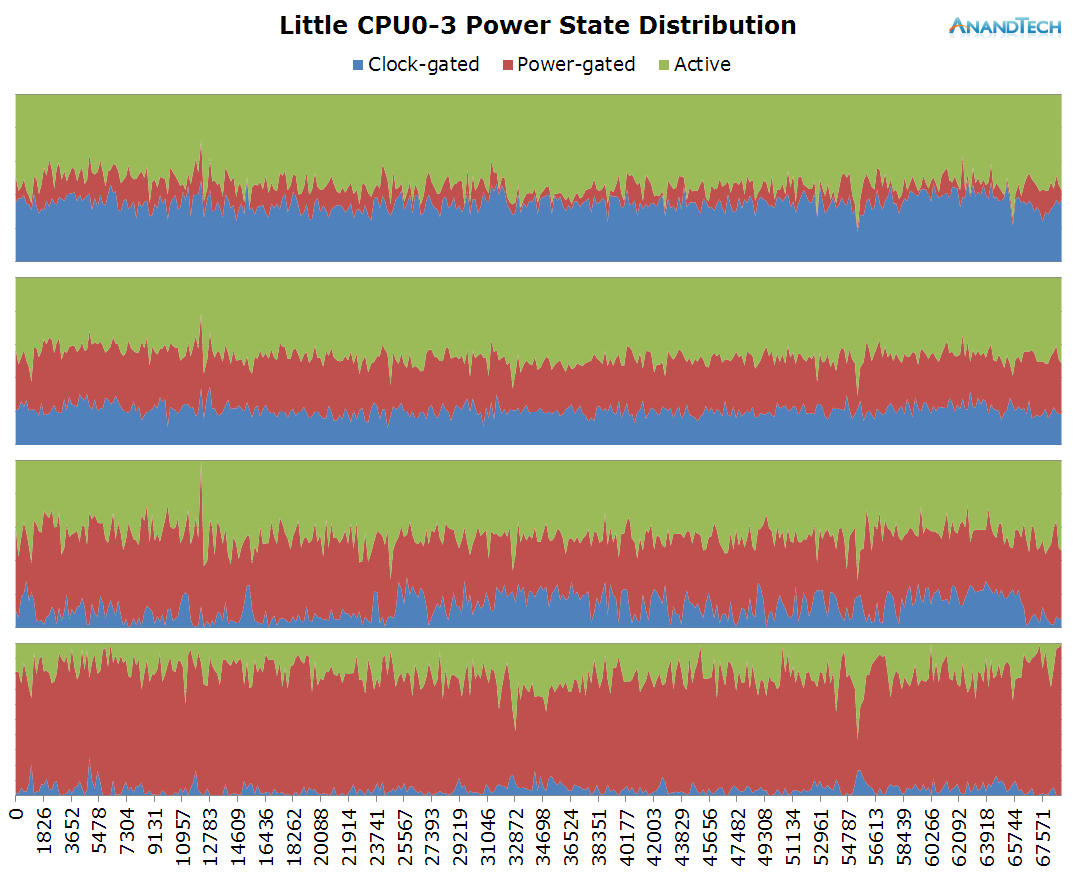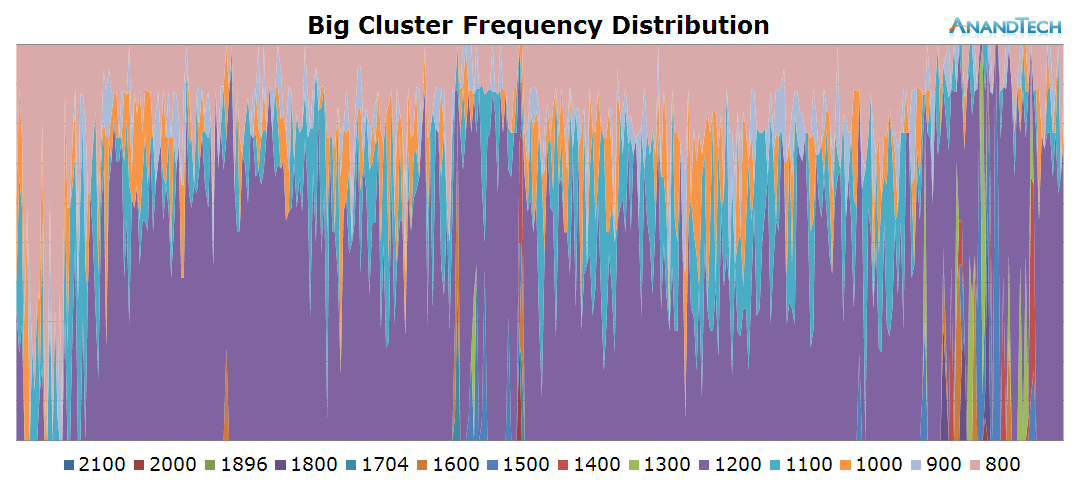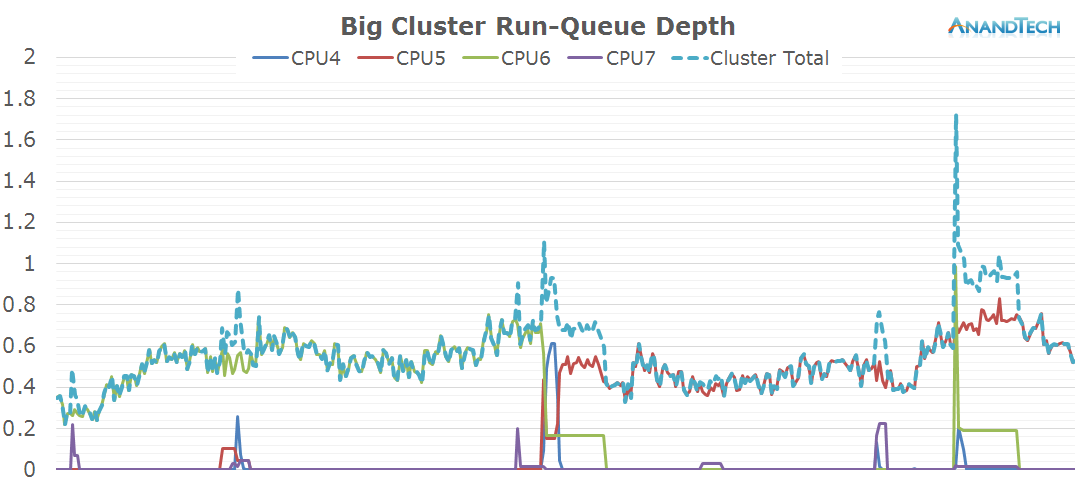The Mobile CPU Core-Count Debate: Analyzing The Real World
by Andrei Frumusanu on September 1, 2015 8:00 AM EST- Posted in
- Smartphones
- CPUs
- Mobile
- SoCs
Modern Combat 5 Playing
The little cluster looks to behave extremely similar to what we saw in Real Racing 3: Three larger threads keep 3 of the cluster's CPU at relatively busy duty-cycles while we see some limited activity on the 4th core.
The big cluster also seems to behave in a similar fashion. One big main thread causes the bulk of the load while we only have occasional small bursts when threads get migrated onto the big cluster. This time we see a more variable load both in terms of requency and rq-depth instead of the flat-line that could be observed in Real Racing 3.
One interesting behaviour caught in this log was how the main big thread got moved around from CPU6 to CPU4 and then again to CPU5 on the 33s mark in the log.
Even though the total rq-depth might be a bit misleading here while it's showing an average of around 2.5, we can see that in the individual per-CPU runqueues we have 4 major threads at work. Again this is a case of using parallelization for the sake of power efficiency instead of performance. The 3 smaller threads on the little cores could have well been handled by a single larger CPU at higher frequency, but it wouldn't have been nearly as power efficient as spreading them onto the smaller cores.

















157 Comments
View All Comments
lilmoe - Tuesday, September 1, 2015 - link
"If 4 threads running on 4 small cores at 50% FMax can be done by one big core at FMin without wasting any cycles, the advantage actually goes to the big core configuration."That's hardly a real-world or even valid comparison. Things aren't measured that way.
On the chip level, it all boils down to a direct comparison, which by itself isn't telling much because the core configuration of two different chips isn't usually the only difference. Other metrics start to kick in. Those arguing dual-core wide cores are thinking iOS, which by itself invalidates the comparison. We're talking Android here.
On the software side, real life scenarios aren't easy to quantify.
This article simply states the following:
- Android currently has relatively good parallelism capabilities for common workloads,
- Therefore, there is merit in 8 small core and 4x4 big.LITTLE configurations from an efficiency perspective. The latter being beneficial for comparable performance with custom core designs when needed.
Most users are either browsing, texting, or on social media. Most of the games played, BY FAR, are the less demanding ones that usually don't trigger the big cores.
I've said this before in reply to someone else. When QC and Samsung release their custom quad core designs, which do honestly believe would me more power efficient, those chips as-is? Or the same chips in addition to little cores in big.LITTLE (provided they can be properly configured that way).
A wise man once said: "efficiency is king".
lilmoe - Tuesday, September 1, 2015 - link
You guys are deliberately stretching the scope in which the findings of this article applies to.Just stop.
It has been clearly stated that this only applies to how Android (and Android Apps) manage to benefit from more cores in terms of efficiency. It was clearly stated that this doesn't apply to other operating systems "iOS in particular".
Nenad - Tuesday, September 1, 2015 - link
I agree.Especially since any app designed for performance will launch as many threads as needed to use available cores. So looking if "there are more than 4 threads active on 4+4 core CPU" can be misleading. If you run those tests on 2 core CPU, would number of threads remain same or be reduced? How about 10 core CPU?
In other words, only comparing performance and power usage (and not number of threads) would tell us if 4+4 is better than 4 or than 2 cores. Problem with that is finding different CPUs on same technology platform (to ensure only number of cores is different, and not 20nm vs 28nm vs different process etc).
Barring that, comparison of power performance per cost among 4+4 vs 4 vs 2 is also better indicator than comparing number of threads.
TD;DR: it is 'easy' to have more threads than CPU cores, but it does not indicate neither performance nor power usage.
ThisIsChrisKim - Tuesday, September 1, 2015 - link
The question being answered was this, "On the following pages we’ll have a look at about 20 different real-world often encountered use-cases where we monitor CPU frequency, power states and scheduler run-queues. What we are looking for specifically is the run-queue depth spikes for each scenario to see just how many threads are spawned during the various scenarios."It was simply assessing if multiple cores were actually used in the little-big design. Not a comparison of different designs.
Aenean144 - Tuesday, September 1, 2015 - link
Yes, that was what the article was trying to find out, but it didn't answer the question of whether 4-core and 8-core designs are better than 2 core or 3 core designs. That's been the contention of the "can't use that many cores" mantra.All this article has explained is that the OS scheduler can distribute threads across a lot of cores, something hardly anyone has a problem with.
What I'd like to see is the performance or user experience difference between 2-core, 4-core, and 8-core designs, all using the same SoC. There's nothing magic about this. In PCs today, we've largely settled on 2-core and 4-core designs for consumer systems. 6-core and 8-core systems for gaming rigs, but that's largely an artifact of Intel's SKUs.
So, if I believe the marketing, these smartphones really need to have 8-core designs when my laptop or desktop, capable of handling an order of magnitude more computation needs, with just 2-cores or 4-cores?
prisonerX - Tuesday, September 1, 2015 - link
You're missing the point. Your desktop is faster because it uses much more power. Mobile phones have more cores because it's more efficient to use more lower power cores than fewer high power cores.Aenean144 - Tuesday, September 1, 2015 - link
My desktop and laptop are power limited at their respective TDPs, and it's been this way for a very long time. If more cores were the answer, why are we sitting at mostly 2-core and 4-core CPUs in the PC space?All this stuff isn't new whatsoever, and the PC space went through the same core-count race 10 years ago. There has to be something systematically different such that Intel went down this path while ARM smartphones are in the midst of a core-count race.
I've read that it could be an economics thing as ARMH gets money on a per-core basis while spending money on complicated DVFS schemas and high IPC cores isn't worth it for them. Maybe in the PC space, we don't need the performance anymore.
mkozakewich - Wednesday, September 2, 2015 - link
It's because we're always fighting for quicker single-thread work. A lot of things can be parallelized, but there are also a lot of things today that aren't. I agree that Intel should try out some kind of big.LITTLE thing with a couple Atom cores and a Core M, just to see how it runs.prisonerX - Wednesday, September 2, 2015 - link
It's Intel's backward looking strategy. They're competing in high power/high single thread performance because they can win that with legacy desktop software and a legacy CPU architecture.Meanwhile, the rest of the world is going low power multithreaded, because that's the future. Going forward it's the only way to increase performance with low power. Google are correctly pushing an aggressively multithreaded software architecture.
Intel have already hit the wall with single threaded performance. They can win the present but not the future. Desktops aren't moving forward because no-one cares about them except gamers, and gamers largely don't care about power usage because they don't run on batteries.
Frihed - Friday, September 4, 2015 - link
In the desktop, the costs of making a chip matters much more, as the bigger chips are some times more expensive than a hole mobile device. The costs of putting more cores in the chip counts there.